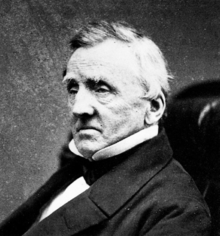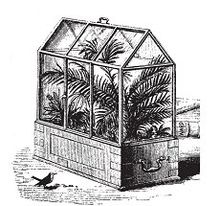Nathaniel Ward
Nathaniel Bagshaw Ward (* 1791 in London ; † June 4, 1868 in St Leonards , Sussex ) was an English doctor who made portable greenhouses popular with his "Wardschen box" from the 1830s . Ward is often referred to as the "greenhouse inventor" to this day, but the Scot Alan Maconochie had already discovered the greenhouse phenomenon in 1825 using a wooden box with a glass lid, but remained silent about it after Ward's publications.
Life
Nathaniel Ward was born in London in 1791 to the doctor Stephen Smith Ward. As a child he was already collecting insects and plants and was particularly interested in ferns . As an adult, he continued to work in the field of botany in addition to his medical work .
In 1817 Ward became a member of the Linnean Society of London .
In the summer of 1829 he experimented for the first time with an earth-filled vessel, which he closed with a glass lid. He noticed that the evaporation moisture rising from the earth was deposited on the lid and dripped back onto the earth. The first plant seeds germinated after about a week with the moisture level remaining constant. In closed glass containers, lovers of tropical plants in other climates could create a miniature jungle. In 1833 Ward sent two specially made glass cases with ferns and grasses on the sea voyage from England to Australia and back, which at the time was still several months. Although the plants were never watered, they showed no impairment even after more than a year. Ward then made his invention known and collectors of exotic plants could henceforth not only transport seeds but also live plants in these mini greenhouses successfully over long distances.
Wardscher box
Ward's invention was named Ward shear box famous and was from 1835 to the botanical discovery and collecting journeys by plant hunters used to plant intact to be able to transport several months by ship.
The Wardsche box is one
“Device for transporting and cultivating plants under otherwise unfavorable conditions consists of a flat, metal, well-painted floor piece on which a metal frame for holding glass plates rises. The latter form the side walls and the ceiling of the box. The bottom piece, which has a rim a few inches high, is filled with soil, the seeds or plants are stuck into it, watered and then the box closed completely. The plants thrive, because they are protected from dust and sudden changes in temperature and have sufficient moisture, as the water can never evaporate. For tropical plants it is easy to set the right temperature with the help of a small oil or spirit lamp. In England and, more recently, several times in German-speaking countries, Ward's boxes are used in elegant furnishings for cultivating more delicate plants in the room. The services they provide when moving plants are important. Fortune used them to transport thousands of tea plants to the Himalayas, Virginia and California, and Haßkarl transplanted cinchona trees from America to Java with their help . See Ward, Observations on the growth of plants in closely-glazed cases (2nd ed., Lond. 1854) . "
In the “Long House” of the Orangery in the Belvedere Park in Weimar, the Wardsche Kasten can be seen in a new, modern design.
Ward's bottle
A variant of the box, which is laborious to manufacture and seal, is the planting of a bottle, a glass balloon with a capacity of more than 3 liters up to around 25 liters. Such glass balloons were produced in series for the transport of wine and vinegar and usually packed in a basket (" Fiasco basket bottle" as with Chianti wine ). Once planted, poured and plugged with wooden tweezers, the bottles or plants were shipped that way.
literature
- Stephanie Hauschild and Melanie Wagner: Green under glass. Easy-care houseplants , Ostfildern 2011.
- Nathaniel Bagshaw Ward: On the growth of plants in closely glazed cases. John Van Voorst, Paternoster Row, London, 2nd ed., 1852.
Web links
Individual evidence
- ↑ a b c d Jane Tresidder, Stafford Cliff: Living under glass. Fascinating glass houses, kindergartens and verandas from yesterday and today. Bauverlag, Wiesbaden and Berlin, 1986. ISBN 3-7625-2488-2 , p. 8
- ↑ Wardscher box . In: Meyers Konversations-Lexikon . 4th edition. Volume 16, Verlag des Bibliographisches Institut, Leipzig / Vienna 1885–1892, p. 389.
| personal data | |
|---|---|
| SURNAME | Ward, Nathaniel |
| ALTERNATIVE NAMES | Ward, Nathaniel Bagshaw (full name) |
| BRIEF DESCRIPTION | British doctor, inventor of Ward's box for transporting plants |
| DATE OF BIRTH | 1791 |
| PLACE OF BIRTH | London |
| DATE OF DEATH | June 4, 1868 |
| Place of death | St Leonards , Sussex |



